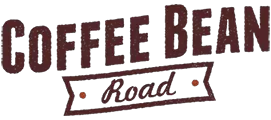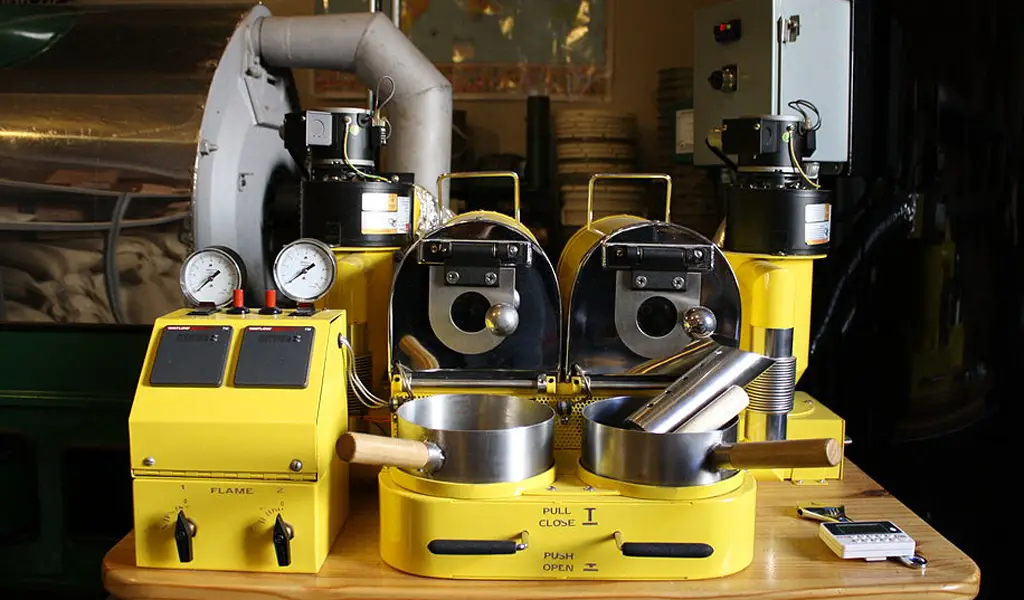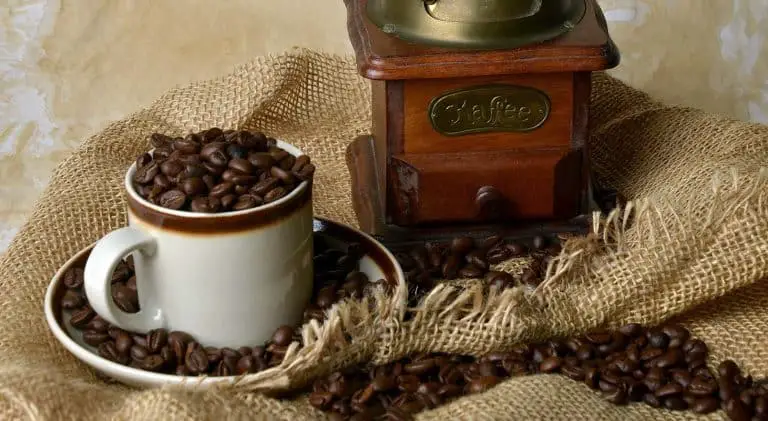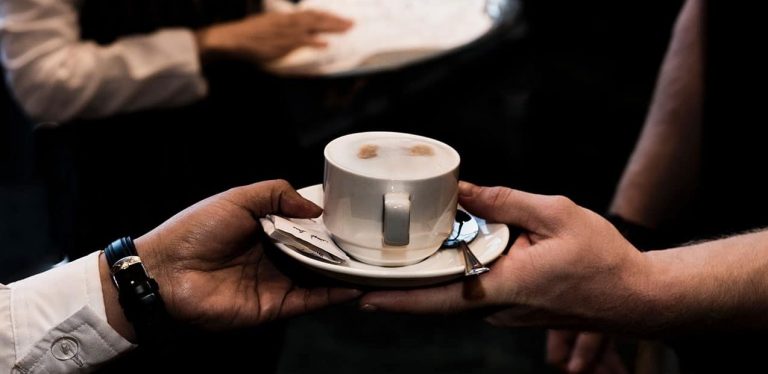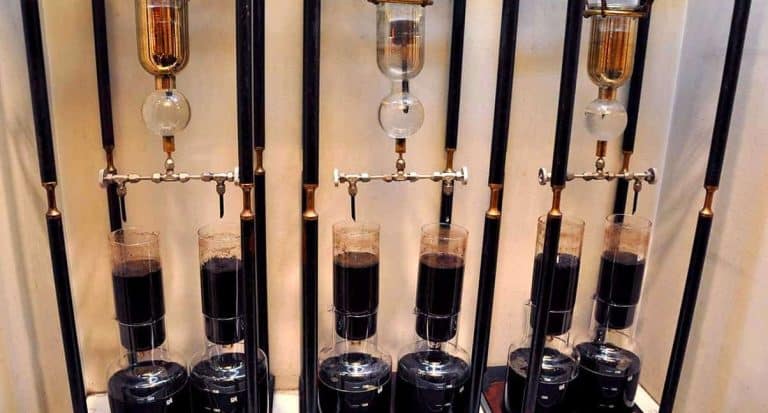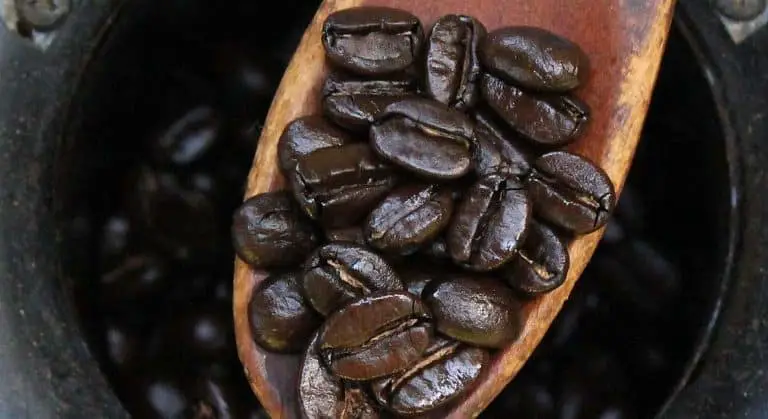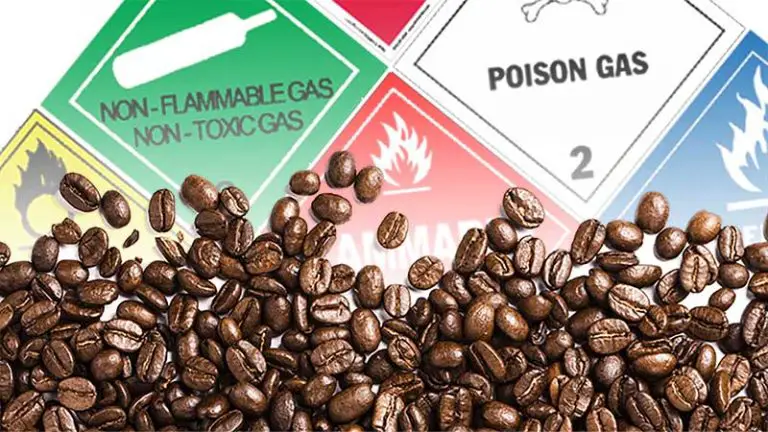How to Choose the Perfect Coffee Roasting Machine (cost, size, type, economics)
Coffee roasting machines vary hugely in complexity and price. Here I’ll give you a guide to finding one to serve your immediate and future needs. With a few questions and bit of knowledge you can narrow it down so that your coffee roaster for home doesn’t break the bank but still serves your purposes well into the future.
If you are just starting out in roasting you wouldn’t want a machine that’s too complex. On the other hand, your tastes and ability to discern will develop quickly and you will need a coffee roaster that can develop with your abilities.
Roasters can be quite expensive, even on the lower end and an extra $50 could put you into a whole class of machine. There’s nothing worse than walking perfectly functional machinery to the curb because you’ve outgrown it.
Here’s a list of things to consider when buying a coffee roaster for home:
Contents: (click to jump)
- Your Budget
- Small Roasting Pans
- Re-purposed Popcorn Poppers
- Entry-Level Fluid Bed (Hot Air) Roasters
- Manual Drum Roasters
- Mid-Level Drum Roasters
- Mid-Level Fluid Bed Coffee Roasters
- Matters of Size
- The Ultimate Purpose
- The Economics of Choosing a Coffee Roaster
- Roaster Configuration – Pros and Cons
- Automation
- Roaster Technology in the Near Future
- Conclusion
Your Budget?
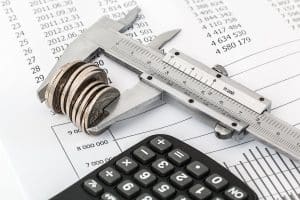
When we define a budget for anything it’s never just the simple matter of writing down a single number. There are many factors to consider and I’ll be covering them in detail below. That being said, there are logical value points to consider when purchasing a coffee roaster for home use.
Here’s a basic breakdown of the price ranges in order of price and complexity to give you an idea what the different roasting options cost.
Small roasting pans
Price range $25 – $65
Requires gas or alcohol fired burner. Some of these are simple pans and others are nut roasting pans with an integral mixing paddle or stove top popcorn poppers. Foolproof and can be portable but difficult to roast consistently. Great, low cost way to begin. Check the prices for two popular coffee roasting pans – a metal one here and a Korean ceramic one here on Amazon.

Re-purposed Popcorn Poppers
Price range $25 – $45
Popcorn poppers are obviously not designed to roast coffee but with a bit of care and oversight they can a surprisingly good roast. They use hot air to roast but have no speed or temperature control. Control over the roast is achieved is by the roasting and quantity of beans in each batch. Larger batches will take longer to reach roasting temperatures because the beans circulate slower. Too few and they roast too fast – too many and the stop circulating and can roast unevenly.
Caution: these machines are not designed for coffee beans and won’t hold for a long time and are not designed for the sustained temperatures of coffee roasting. Some of the newer poppers are low wattage and don’t reach the temperatures required to roast coffee properly. There’s a bit of trial and error never leave them unattended.
The good thing is that they aren’t expensive and can be a good way to get your feet wet. I find that they become limiting as you progress and want to control different aspects of the roast. You’ll likely find yourself wanting to upgrade to something purpose made in a few months.
Manual Drum Roasters
Price Range $55 - 150
These are entry level, rudimentary drum roasters. At this price range you’ll find that they are built quite lightly with thin gauge, perforated sheet metal drums and frames fabricated from bent steel rods. The drum is rotated either by a hand crank or a electric motor. Don’t expect something durable that will last you years with this class of roasters.
They do tend to be bit flimsy and may not be good value if you see yourself as a roaster that’s here to stay. If you don’t roast often, they’re fine but for frequent roasting I would recommend something more durable.
The rotating drum on these units allows better control and variability of the roasting process than pan roasters and popcorn poppers. Also, cooling can be more effectively controlled by simply removing the heat source. Pan roasters tend to hold heat for a while so beans can’t be effectively cooled in the roaster like these. Some models are configured to work with a gas barbecue and a standard barbecue rotisserie.
Entry-Level Fluid Bed (Hot Air) Roasters
Price Range: $150 - 270
These are a real option for a serious beginner and are small capacity fluid bed roaster which roast by blowing hot air into the bottom of a cylinder containing beans. This method roasts very evenly and efficiently. It also has a cooling cycle which rapidly stops roasting at the desired point. The great thing is that the cylinder is made of glass and you can observe the whole process closely. Control is achieved by varying fan speed and/or the hot air temperature. You can check out reviews for the The French Roast SR340 on Amazon. Its a really popular and reliable option for an entry level fluid bed roaster and has been around for years. They make
Mid-Level Drum Roasters
Price Range: $350 - 650
These roasters are more serious machines and are well built and serviceable with replacement parts available. They are designed to last for a number of years if maintained. They’re available in manual and automatic timing versions.
To produce quality roasted coffee is a process and a very personal process at that. It’s almost never achieved on the first go round. Many advanced coffee roasters see it as an art form, and rely on “seat of the pants” skills to produce the ultimate roast. Others prefer automation because of the repeatability and because they like to fine-tune the roasting cycle incrementally.
It will usually take a series of roasts with adjustments to the timing/temperature of each stage to perfect a roast. This sequence of temperatures and times is known as the roasting profile. Ant the big question is: Do you go automatic - or manual?
Automatic Drum Roasters
This class of machine allows roasters to dial in the desired roasting profile giving you the ability to constantly fine tune your roasting and adjust it until it’s to your taste. It gives you automatic repeatability which is not possible with other simpler roasters without years of experience. Get it right - save the settings - and repeat. If you’re a busy home roste, automatic roasters are for you.
Manual Drum Roasters
Professional photographers will almost never set their DSL to auto mode. For much the same reason, professional roasters don’t like automation. They have developed their skills to the point that it’s intuitive.
For these analog WW1 seat-of-the-pants fighter pilots, all they need is a quality manual drum roaster, watch, thermometer and their senses. Although I’m far from being an one of these experts I feel more involved in the process when roasting manually.
The manual drum roaster I really like is the Kaldi 200g Manual Roaster because it's solidly built and is really durable and there is very little that can go wrong with it.

Mid-Level Fluid Bed Coffee Roasters
Price Range $2,800 to $5,000
There seems to be a gap in the fluid bed roaster market between the consumer grade, entry level roasters and the next step up. There doesn’t seem to be much in the $1500 to $2500 range. Fan speed and heater temperature are controlled separately.
These are really small batch, commercial sample roasters and are built to heavy commercial standards. They are tabletop units generally have 1 to 5 lb batch capacity which is on the large size for a home roaster. The same gap exists in the drum roaster offerings too. If you have the money to spare, these units are the way to go.
Here's a video of a large commercial fluid bed in use.:
Matters of Size
Considering Value
Value when selecting a roaster depends on how involved you see yourself becoming in the hobby. Occasional roasters will be ok with a simple pan roaster but more serious involvement will see you outgrowing entry level roasters fast.
It may be better to buy the more complex, better constructed roaster rather than the entry level unit. Even if you won’t use all of the features initially it could work out cheaper than buying two units over time.
Also cheaper, less substantial units won’t hold upto the heat as well as better constructed roasters. The better unit also have spare parts available whereas the cheap units will have to be replaced if something goes wrong. They are also usually sold without warranty.
Deciding on Batch size
The batch capacity of each roaster type affects the purchase price and size of the roaster.
Manufacturers see larger batch sizes as added value and sometimes the price increase doesn’t make sense. It could be better to just roast two 8oz. batches rather than one 16 oz. batch in a bigger machine.
Also, you may find you have paid for the increased capacity for no reason if you end up roasting smaller batches more often. This may be because you want to keep freshly roasted beans on hand or you want variety.
Some of the better quality, prosumer home roasters will only be available with larger capacities and you will have to pay to get the quality and feature set.
The Ultimate Purpose
There are many reasons to buy a home coffee roaster. You could be:
Starting Out as a Hobby
If you’re just testing the waters, the best way is to start roasting in a cast iron skillet on your stove or in a nut roaster or popcorn popper. Yes you’ll most likely grow out of them in a short time if you get more involved but you’ll not be investing a lot in equipment up front. Hey, you may even want to make popcorn in the popper if you upgrade.
The downside to these methods is that it’s difficult (not impossible) to consistently produce a quality roast. This may end up turning you away from a satisfying hobby you may have enjoyed if you had the right equipment. There’s always the value equation too so if you think you could stick with it, buy a better quality machine. You could always sell it if you lose interest. There’s no real resale market for the no-name cheaper roasters.
Looking to Upgrade from a Basic Model
If you’re looking to upgrade, there are a few things to consider. Simpler roasters like pans can be simply thrown in the kitchen cabinet. More expensive units are like appliances, are heavy and take up counter space. Either you need a dedicated spot to set up with the roasting, grinding accessories nearby as well as the beans. This takes place and for larger units it’s better to choose a permanent place to set up.
Also, you may be roasting larger batches which create more fumes. You may need mechanical ventilation or be remotely located. Fumes can be an issue with coffee roasting. Even if you’re OK with it, the neighbors, or your family may not be as enthusiastic as you are about basking in the roasting fumes.
I touched on this above in Batches - you may want to roast small batches often and upscale roasters have minimum quantities. Check this out before upgrading to make sure you can roast your desired batch size.
Investigating Coffee Roasting for Supplemental Income
The scope of this is huge so I’ll just be able to touch on it here. I’ll be writing an article specifically about starting in the business in the near future.
It makes sense to think that a coffee roasting hobby can turn into something that can earn you money. The truth of the matter is that there’s a world of difference between buying for a hobby and buying equipment for a business. My gut feeling is you do one or the other. Get familiar with it as a hobby. Then get serious and evaluate it and launch it as a business if it makes financial and marketing sense.
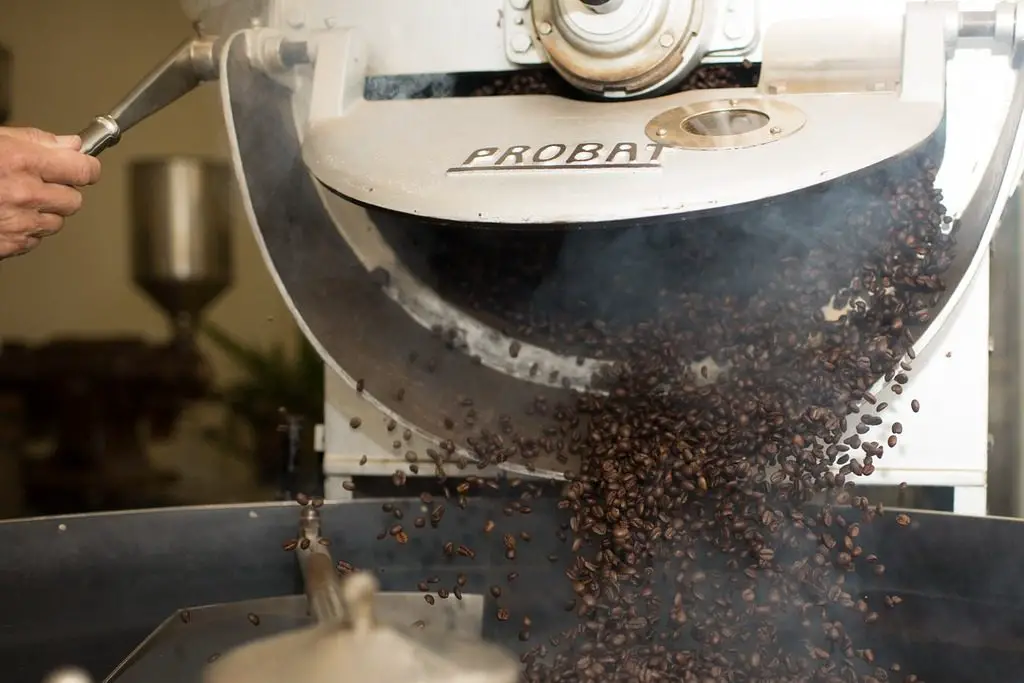
The Economics of Choosing a Coffee Roaster
The economies of scale of commercial coffee production are a necessity if you want to survive in the very competitive roasted coffee market. If you want to sell smaller batches as a “boutique” roaster be aware that you will have a lot of very skilled and talented competitors and many of them have been established in the business for years. They also have established supplier networks in place. Many have brick and mortar stores and can leverage other markets in marketing their roasted coffee. There is allure in being around a beautiful commercial roasting machine. Coffee is sensory and the in-person experience is extremely important. Selling sight unseen needs a unique selling feature to succeed in the chaos and noise of the coffee market.
This is not to say you can’t compete, but you would need your own unique angle. There is a trend towards sourcing beans from micro farming sources. These are small sustainable coffee farms which are ecologically responsible and produce quality products. Here is an opportunity to sell the story behind the unique beans and attach emotion to the sale of the beans.
Investment vs. Revenue
The main consideration is with a business you can justify quite considerable upfront investment because it will create revenue. It’s much harder with purchases for a hobby. Also the class of the machine is different. If you look at commercial roasting machines you will know what I mean. They are heavily constructed from thick cast or milled metal and are meant to be permanently installed in a location. They’re expensive too and will sit idle for days if you roast large batches.
The power and gas burner requirements and also quite demanding and I’m not even sure most residential zoning allows for it. This is a huge subject and as mentioned, I’ll be writing an article covering in the near future.
Length of Ownership and Trade up
This should be a simple calculation based on how long you foresee owning each coffee roaster. The question is do you buy the more expensive model first and grow into it, or trade up and sell your old one. This of course assumes there is a second hand market.
Current used prices can be found on eBay.
Scenario 1 - Trade Up
I buy a $100 roaster and keep it for a year, sell it and upgrade to a $300 unit which I use for 4 years. Assuming I sell the first for $40 (40% of price) I’m out of pocket $60 because cheaper units don’t have good resale. Total cost of ownership is $360 or $72/year.
If I lose interest in the first year, I’m ahead and only lose $60 on the resale. If you are into camping and hiking, just keep it.
Scenario 2 - Start with better roaster
I buy the $300 unit from the start. My cost is $60/year. If I lose interest in the first year I can sell the roaster for $225 (75% of price). Better, brand name units hold their value. If I keep using the roaster I’m ahead. I also expect that more expensive roasters can be used past the five year mark because they can be serviced.
The price difference/advantage really seems minimal over the long term. The only advantage to be gained by getting into roasting with a cheaper roaster is if you’re not sure you’ll keep doing it. But bear in mind that there’s a lot of other equipment you will need including a grinder etc.
Portability
If you like to hike, camp and go on fishing trips there are portable roasting solutions. Most of the time a simple small roasting pan will suffice. It can be placed over a wood fire as it burns down or over a gas stove. There’s nothing like sitting around a campfire with the sweet aroma of roasting coffee beans wafting up. Many of the small hand held roasting pans can fit in a backpack and are an ideal solution.
Even for roasters used in the home, portability is a factor. Large roasters are inconvenient to set up all the time. It means lugging them with accessories out of storage each time you want to roast. The more inconvenient, the less you will find yourself using them. These roasters should really be permanently set up so you just need to load, set and roast.
This is where the smaller units become useful because hey are simple to place on a table or counter and convenient to store in a lower kitchen cabinet. Most home roasters don’t end up roasting large batches - usually between 4 and 8 oz, so these are ideal. They are also much quieter and don’t put out the volume of fumes their big cousins do. A small fluid bed roaster is ideal for this because it roasts so quickly.
Roaster Configuration - Pros and Cons
Ultimately, any discussion on how to choose a coffee roaster for home will come down to this: pan, fluid bed, or drum roaster. Each has its advantages and disadvantages and roasters who will almost give their lives for their cause. Discussion can get heated! Here’s my simple take on it.
Roaster Type | Pros | Cons |
Drum Roasters | Simple and reliable foolproof design Long parts service life. Can use a variety of heat sources Can be fully manual or automatic Gives full manual control of process Available in a variety of sizes Great traditional aesthetics Tried and tested | Beans in contact with drum can burn
Harder to control and duplicate roast Longer roast time can degrade flavor Burn coffee chaff leaving charcoal in roast Burned chaff could be carcinogenic Have horizontal design so take up more space. |
Fluid Bed Roasters | Can be expensive and complex
Consistent roasting all beans Easy to control and duplicate roast Short roast time retains flavor Blow chaff off before it burns Small footprint because of vertical design Modern aesthetics | Can’t effectively inspect beans as they roast
Can’t smell or hear roasting beans “pop” Can’t continually check beans as they roast Complex closed system difficult to maintain Software control - roaster not aware of process Designs can be ugly (subjective) Tend to have limited capacity |
Pan Roasters | Inexpensive
Simple with few or no moving parts Can use repurposed equipment Traditional way to roast beans Portable, great for camping Uncomplicated | Little to no repeatability
Uneven roasting of beans Difficult to maintain constant heat source |
Automation
The idea with coffee roasting is to achieve the perfect roasting profile for each type of coffee bean. Automation makes achieving that elusive perfect profile much simpler.
There are two technologies used to automate roasting profiles. The older type uses thermostats for temperature and timers for fan and roasting cycle times.
Thermostats
Thermostats switch off when a preset temperature is reached. When the temperature drops by a preset amount, it switches back on. It is either full on, or off. The difference between the on and off temperatures results in a fluctuation of the roasting temperature. The temperatures can’t be too close because it would cause the thermostat to cycle on and off too quickly. This fluctuation in temperature affects repeat-ability. Thermostats however are cheap and easy to replace.
PID Controllers
PID Controllers is an electronically temperature control system which measures the actual temperature of the beans and the roasting chamber and constantly corrects the temperature. Instead of a simple on-off control, it uses a feedback loop to measure the actual temperature and can increase or reduce the heat source incrementally.
Instead of the on-off relay of the thermostat system, it uses a solid state relay which controls the current to the heater. There is little to no fluctuation and temperature remains constant no matter the size of the batch. Most higher end automatic roasters use PID controllers.
Roaster Technology in the Near Future
Home coffee roaster technology trickles down from commercial roasters. Most roasters control the process by varying the two variables - time and temperature. This controls the New technology introduced by a German company Buhler uses a specially shaped roasting chamber to control the air to bean ratio. It’s called InfinityRoast. It's all industrial scale stuff right now but I'm sure, like most other high end tech, it will find its way into consumer products.
Fluid bed roasters have high air to bean ratios while drum roasters have low ratios. This introduces one extra variable into the roasting process which allows for more adjustment in the roasting process.
Soon I’m sure these will be introduced into the coffee roaster for home use. Not only will we be choosing between drum, fluid bed, pan roasters but in the near future we’ll be adding Infinity roasters to this too.
Conclusion
Maybe, for me, it’s time to dig out the old roasting skillet again and dumb it down even more. It's tempting but...I just cant get away from all the equipment that's available. I have to keep reminding myself that ultimately it's about the coffee I rink and not so much about the equipment.
We can go on forever finding better and more expensive and elaborate roasting equipment. Do I really need that commercial grade drum roaster that sells for over $2 000? No, I don't but I really enjoy thinking about it. My wife cools it my man toy fetish. But when it comes down to it, I really enjoy the hands-on experience I get when I dig out my $20 heat gun and a stainless steel bowl.
After roasting, I emerge from the kitchen covered in chaff, reeking of coffee smoke - I love it and emerge looking forward to finishing the batch and trying to get the next one better be it on my drum roaster or simply roasting it with my heat gun.
